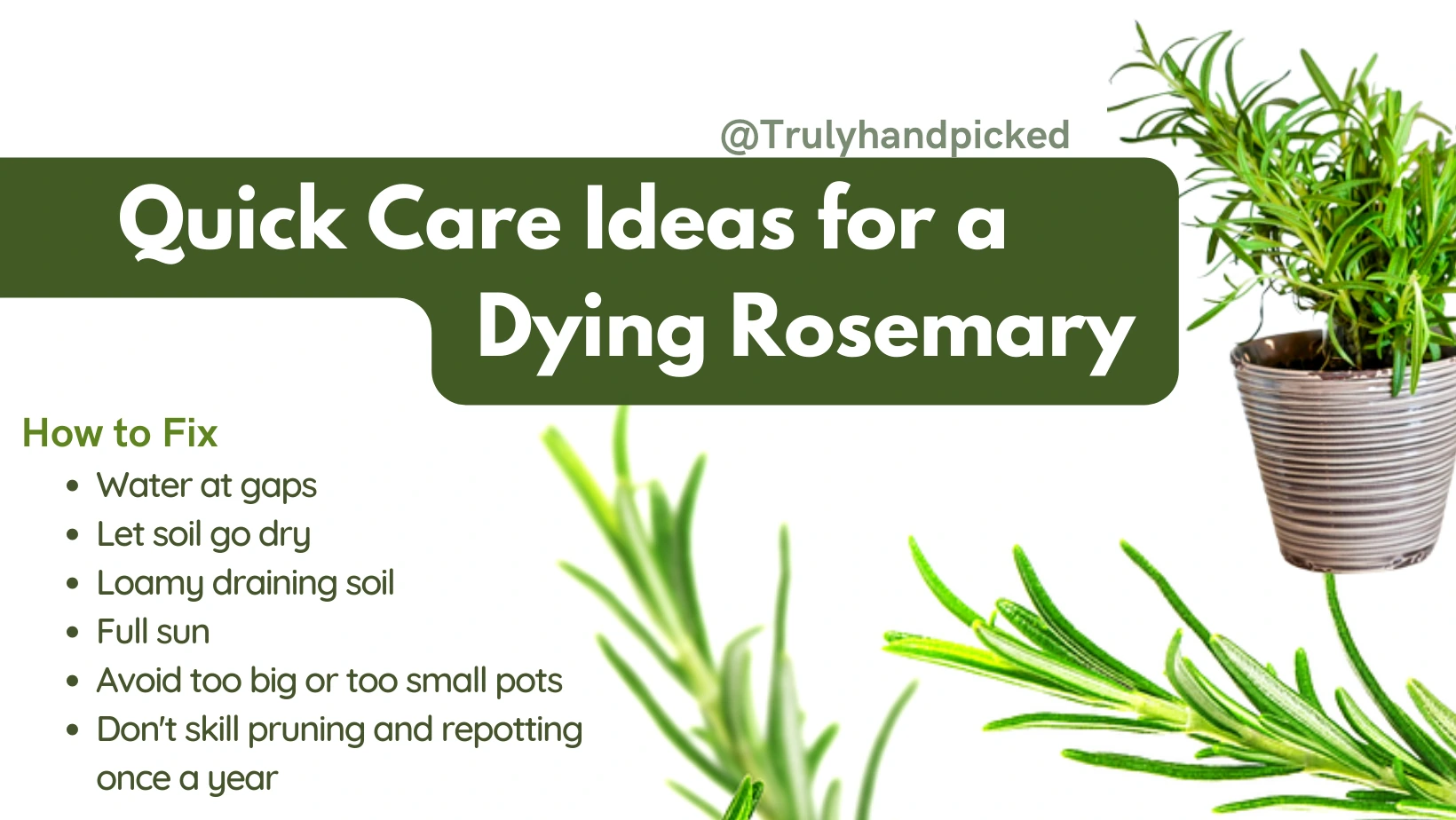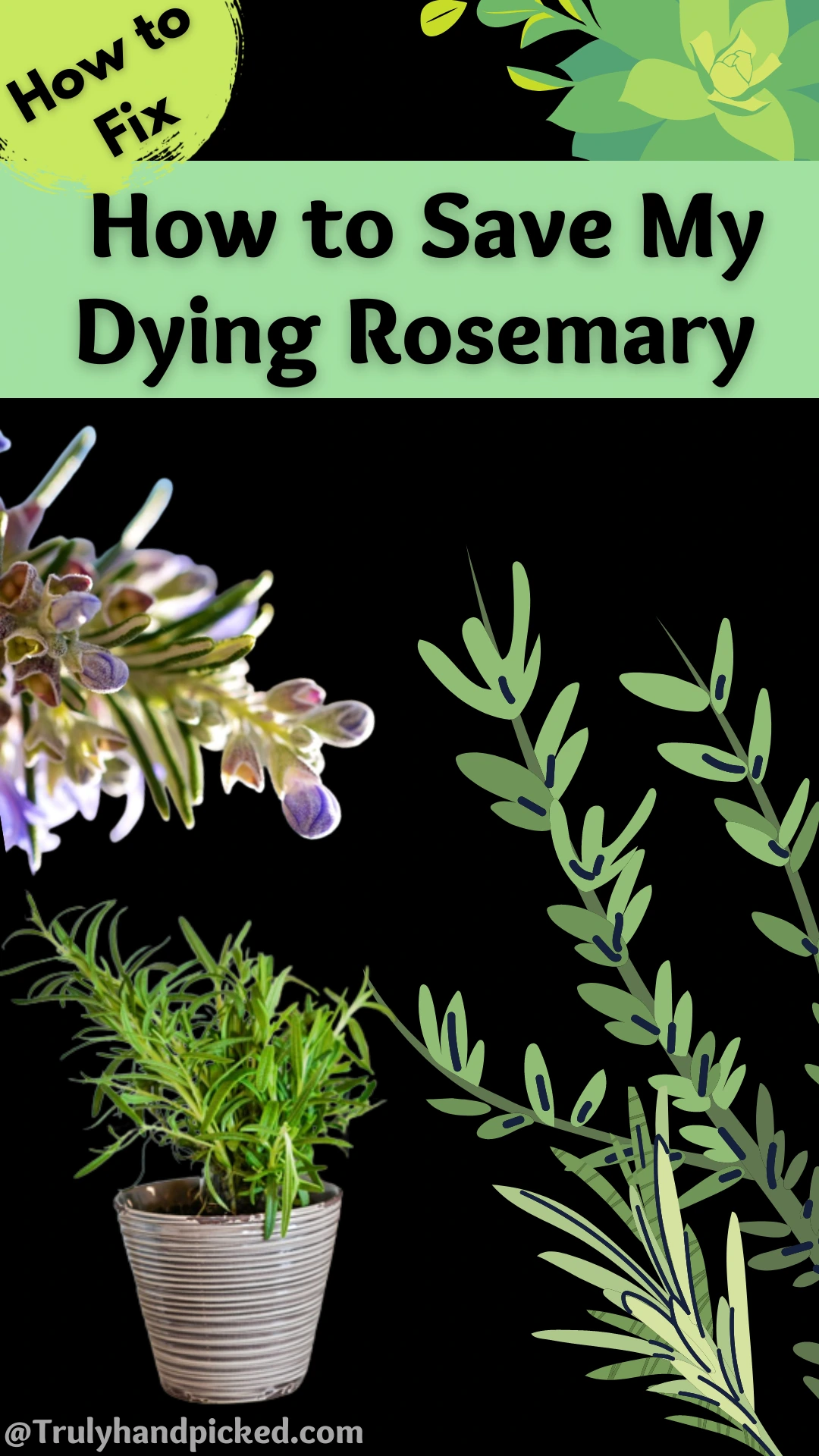Salvia Rosmarinus aka rosemary is a noted flowering shrub. This plant is immensely popular for its medicinal properties.
Apart from its therapeutic benefits, rosemary plants provide an abstract beauty, especially when blooming. Needle-like leaves grow in stalks and produce vibrant tiny flowers in clusters.
Blossoms could cultivate in plenty of bright shades, such as purple, pink, blue, or even white, depending on the variety you choose.
Surprisingly, this super beneficial plant is actually very easy to cultivate, even in a small planter! Here are some quick tips on how to grow a rosemary plant perfectly and how to take care of it consistently as a pro gardener-
Why My Rosemary Is Dying? Reasons and Signs
Rosemary is a self-sufficient shrub with herbal goodness. It is efficient enough to handle its plagues expertly, even without additional help. However, sometimes, improper caring methods or back-to-back insect attacks could make your growing rosemary plant sick, seriously.
If you want to be certain whether your rosemary plant is sick or has just its seasonal transformation, you have to look for its true sick signs.
Signs of a Dying Rosemary Plant:
- Fine spores on all parts of the plant
- Black and mushy roots
- Leaf spot
- Browning leaves
- Drying stems and foliage
- Shriveling leaves
- Stunt growth
- Not-blooming
- And sometimes even undefined death
Causes:
The most common reasons for such issues are, like
- Lack of sun exposure and sunlight
- Overwatering is even worse than underwatering
- Too much frost exposed
- Untreated pest or bugs infestation
- Infrequent pruning session
- Lack of repotting session
- Extreme or unnecessary fertilization
- Using an infected potting mix
- Keeping the plant in improper humidity
- Growing plants in soil or planter that couldn’t drain well
- And keeping inattentive to your plant for long.
How to Fix a Dying Rosemary Plant?
If you want to prevent the inevitable dying outcome of a sick rosemary plant, and revive it, you must take some healthy initiatives towards it. To keep the evergreen perennial shrub healthy consistently, follow these steps considerately-
- Water at gaps and let the soil go dry, instead of overwatering it
- Make sure the planter is always in a good draining condition
- Keep the base of the plant moderately dry for the utmost time
- Remove any brown or infected foliage immediately from your plant
- Place the plant under bright and direct sunlight
- Always use potting soil that is sandy and loamy
- Repot a growing rosemary plant once every year
- Do not skip the pruning session ever
- Avoid using a much bigger pot to avoid the root-bound issue
- And keep updated about your growing rosemary plant throughout its entire growing session.
Quick Care Ideas: How to Care for Rosemary
Soil and Water:
Rosemary plants prefer loamy and well-drained type soil, that must be slightly acidic in pH level.
Water your once every 7-10 days. Let the top 1-2 inches of the soil soak a little, between watering.
Sunlight and Climate:
Rosemary thrives best when you put them under full sun. make sure it can get direct bright sunlight for at least 6-8 hours a day.
Provide this shrub with a warm climate with high humidity to give the best thriving condition. Maintain the temperature between 55° to 80° F with good air circulation in the room it stays.
Proper Fertilization:
Rosemary plants are moderate feeders. Feed them with organic fertilization once every 2 weeks.
Use a liquid fertilizer, low in acidic content in a 20-20-20 NPK ratio for the best result. Try to maintain the feeding time during the day, while the temperature is above 50° F.
Pruning and Repotting:
Pruning is a good way to keep this bushy shrub healthy and in shape. You can trim off the hedge, leggy branches, discolored or old leaves, old flowers, etc. all unwanted parts in this segment. Prune a rosemary plant once a year, from the spring to the summer season.
Rosemary plants are quick-grower; thus, you need to replant them in a new pot every year. Pick one size big planter and light as well as fresh potting soil, every time you repot your plant.
Pests and Bugs:
Aphids, mealybugs, spittlebug, thrips, botrytis blight, scales, downy mildew, spider mites, powdery mildew, etc. are some common pests and bugs you may find around a growing rosemary plant.
You should apply homemade remedies, like the stem of water, neem oil, vinegar spray, insecticidal soapy water spray, etc. to get rid of these nuisances effectively.
Pinterest Image: How to Care for Rosemary
FAQ: Is Rosemary Toxic to House Pets?
Rosemary plants and their entire parts are non-toxic to any mammal, including cats and dogs or any other house pets. Due to the richness of therapeutic properties, the rosemary plant never caters to any serious harm to an animal, even if it ingests some parts of this plant.
However, it is an aromatic plant and can provide some mild stomach issues, when ingested in a higher amount. Thus, you should prevent your furry friend to gulp ant part of a rosemary plant, even with a small nibble.
How to Propagate Rosemary:
Propagation of rosemary is easier than you could ever imagine! The best part is that you can grow it in any condition, from seeds, from cuttings, or even through divisions as well. However, regrowing a rosemary plant is always easier through stem cutting. Here we refer to that process in two different growing mediums, let’s check these out-
Propagation in Soil:
- Cut the healthy stem out of the parent plant that is about 4-6 inches long
- Pluck off the leaves from its bottom section, leaves the 2-3 leaves on the top only
- Dip the cutting in some powdery rooting hormone before planting
- Now, bring a new planter with fresh potting soil and sow the cutting into it
- Secure the base well and water it thoroughly
- Place the planter in a warm spot, full of bright but indirect light
- New shoots will come out within 2-3 weeks with the proper climate. Then just give your newly grown plant proper care to thrive well.
Propagation in Water:
- To try this process, collect the cutting in the same process with the same measurement
- Bring a glass full of distilled or filtered water
- Put the cutting into the water carefully
- Make sure you submerge 2-inches of the stem into the water level
- Do not let any leaf drown in the water, or it will make the stem rot
- Keep changing the water steadily every week
- You will find that new roots will sprout within 3-4 weeks
- Let the roots reach the height of 2 inches first
- Now bring a planter with preferred potting soil and replant the cutting carefully.
Whats’ Special About Rosemary: Benefits of Growing Rosemary
Not only for its beautiful appearance or unforgettable fragrances, but the rosemary plant also has many other advantages too. Once you witness the myriad benefits of having a rosemary plant around, you will surely pick this one over any other common houseplants. Here are some typical benefits of a rosemary plant in this attempt-
- Rosemary plants contain a higher number of antioxidants and anti-inflammatory properties
- A growing and healthy rosemary plant can work as a natural air purifier
- The aroma of rosemary flowers can act as a mood lifter
- Can help you in stimulating cognitive and memory abilities
- It can work as a stress reliever
- Antibacterial agents of rosemary herb can fight plenty of bacterial or fungal issues in our bodies
- Rosemary extracts in beauty regimen could enhance our skin cell repair efficiently
- It also helps in fighting suntan and free radicals
- And its essential oil provides amply of good benefits to our body as well as skin or hair undeniably.


